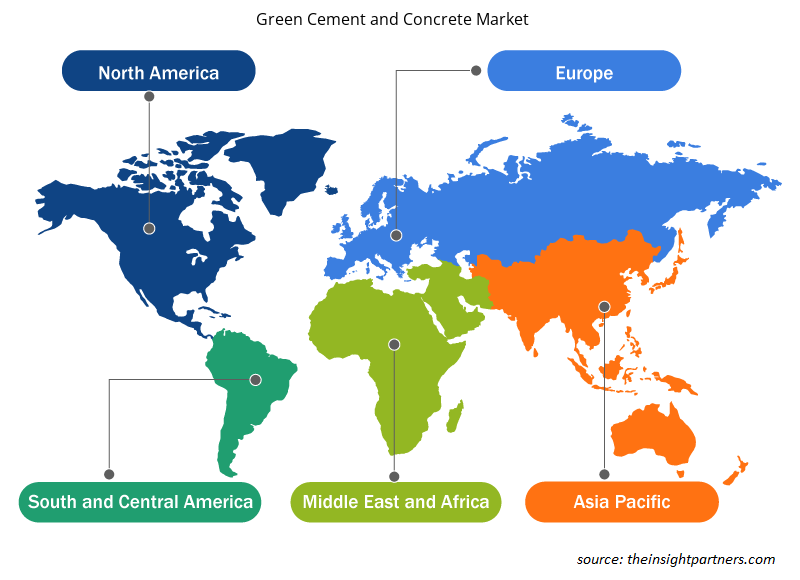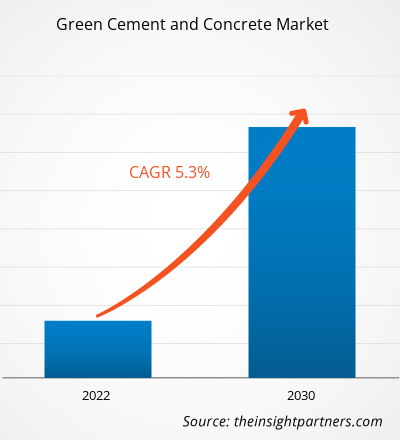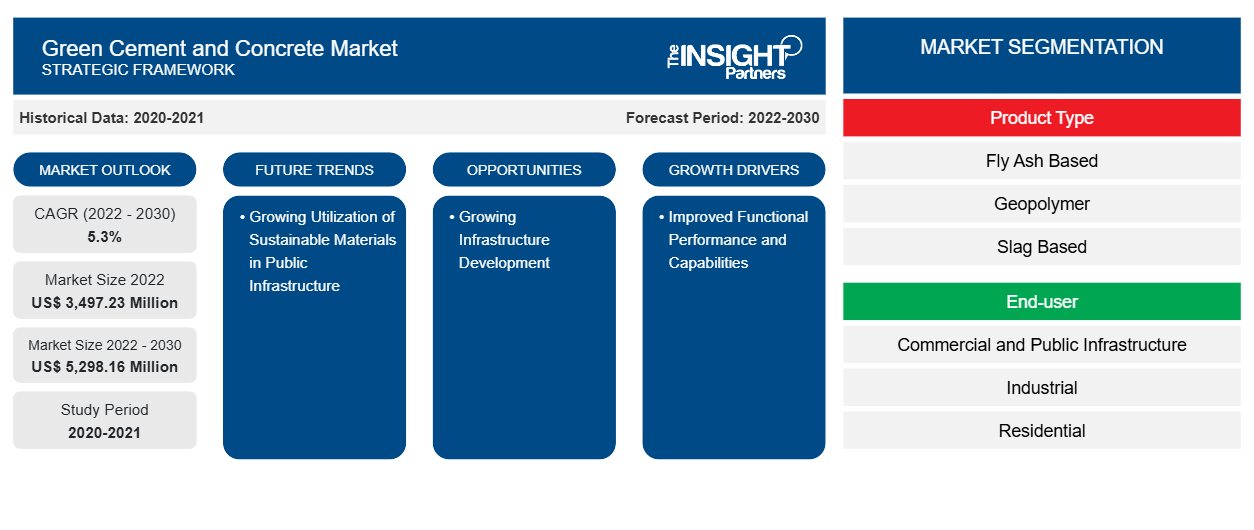Der Markt für grünen Zement und Beton soll von 3.497,23 Millionen US-Dollar im Jahr 2022 auf 5.298,16 Millionen US-Dollar im Jahr 2030 anwachsen. Der Markt soll im Zeitraum 2022–2030 eine durchschnittliche jährliche Wachstumsrate von 5,3 % verzeichnen. Zahlreiche Länder setzen Pläne zur Dekarbonisierung der Zementindustrie um, was die Nachfrage nach grünem Zement und Beton weltweit ankurbelt.
Marktanalyse für grünen Zement und Beton
Die Zementindustrie ist eine der größten kohlenstoffintensiven Industrien, was sich voraussichtlich negativ auf den Umweltschutz auswirken wird. Daher wird erwartet, dass das wachsende Interesse an der Eindämmung der Kohlenstoffbelastung der Umwelt und der Fokus auf zunehmende Nachhaltigkeitsansätze das Wachstum des Marktes für grünen Zement und Beton weltweit vorantreiben werden.
Marktübersicht für grünen Zement und Beton
Die wachsende Regierungsinitiative und die ermutigenden Richtlinien werden voraussichtlich die Integration von nachhaltigem grünem Zement und Beton in die Fundamente der öffentlichen Infrastruktur fördern. So wird erwartet, dass mehrere bevorstehende Infrastrukturprojekte in Indien, wie das Narmada Valley Development Project, Bharatmala Pariyojana, die Chenab River Railway Bridge, Mumbai Trans Harbour Link, Delhi Metro Industrial Corridor und das Navi Mumbai International Project, mit grünem Zement und Beton gebaut werden. Daher wird erwartet, dass die zunehmende Verbreitung von grünem Zement als praktikable Alternative zu herkömmlichem Zement seine wachsende Anwendung im kommerziellen und öffentlichen Infrastruktursektor beibehält.
Passen Sie diesen Bericht Ihren Anforderungen an
Sie erhalten kostenlos individuelle Anpassungen an jedem Bericht, einschließlich Teilen dieses Berichts oder einer Analyse auf Länderebene, eines Excel-Datenpakets sowie tolle Angebote und Rabatte für Start-ups und Universitäten.
-
Holen Sie sich die wichtigsten Markttrends aus diesem Bericht.Dieses KOSTENLOSE Beispiel umfasst eine Datenanalyse von Markttrends bis hin zu Schätzungen und Prognosen.
Treiber und Chancen für den Markt für grünen Zement und Beton
Verbesserte funktionale Leistung und Fähigkeiten treiben die Nachfrage nach umweltfreundlichem Zement und Beton an
Der Produktionsprozess zur Herstellung von Standardzement erfordert eine große Menge Erdgas zu Heizzwecken. Grüner Zement wird aus industriellen Nebenprodukten hergestellt, was den Produktionsprozess energieeffizienter macht. Grüner Zement ist feuerbeständiger und benötigt weniger Abbindezeit als anderer Standardzement. Mit grünem Zement errichtete Konstruktionen haben eine längere Lebensdauer. Der Herstellungsprozess von grünem Zement erfolgt nach hochmodernen Techniken, die den Kohlenstoffausstoß verringern und die Umweltverschmutzung minimieren können. Die Herstellung von grünem Zement erfordert die Verwendung von Nebenprodukten wie Hochofenschlacke, Flugasche und Eisen, die kostengünstig sind. Grüner Zement enthält 0,5–0,6 % Eisendioxid, was dem Zement Festigkeit und Farbe verleiht. Dieser Zement trocknet schnell und schrumpft nur minimal. Er hält länger und ist eine nachhaltigere Alternative für die Umwelt. Grüner Zement bietet außerdem eine hochwertige Wärmedämmung und Feuerbeständigkeit. Grüner Zement ist eine geeignetere Alternative für stark frequentierte Bereiche wie Straßen, Brücken und Flughäfen, da er schwere Lasten tragen kann. Der Markt wird daher von der höheren Leistungsfähigkeit und Haltbarkeit, Festigkeit und Widerstandsfähigkeit von grünem Zement angetrieben.
Wachsende Infrastrukturentwicklung – eine Chance auf dem Markt für umweltfreundlichen Zement und Beton
Die zunehmende Finanzierung nachhaltiger Infrastruktur eröffnet Möglichkeiten für grünen Zement und Beton, fördert die Nutzung umweltfreundlicher Alternativen und fördert die wirtschaftliche Entwicklung. Darüber hinaus bietet sie den Ländern die Möglichkeit, ihre Infrastrukturentwicklung und ihre Klimaziele in Einklang zu bringen, indem sie an Projekten teilnehmen, die den Kohlenstoffausstoß verringern, darunter nachhaltige und grüne Bau- und Fertigungsökosysteme. Die Bau- und Infrastrukturbranche konzentriert sich auf die Reduzierung ihres CO2-Fußabdrucks, da sie der Hauptverursacher der Umweltverschmutzung ist. Daher wird erwartet, dass ein wachsender Fokus auf grünen Zement und Beton bei der Infrastrukturentwicklung große Chancen für den Markt bietet.
Segmentierungsanalyse des Marktberichts für grünen Zement und Beton
Wichtige Segmente, die zur Ableitung der Marktanalyse für grünen Zement und Beton beigetragen haben, sind Produkttyp und Endverbraucher.
- Basierend auf dem Produkttyp wurde der Markt für grünen Zement und Beton in Flugasche-basierte, Geopolymer-basierte, Schlacken-basierte und andere unterteilt. Das auf Flugasche basierende Segment hatte im Jahr 2022 einen größeren Marktanteil.
- Basierend auf dem Endverbraucher wurde der Markt für grünen Zement und Beton in gewerbliche und öffentliche Infrastruktur, Industrie und Wohnen unterteilt. Das Segment der gewerblichen und öffentlichen Infrastruktur hatte im Jahr 2022 einen größeren Marktanteil.
Marktanteilsanalyse für grünen Zement und Beton nach geografischen Gesichtspunkten
Der geografische Umfang des Marktberichts für grünen Zement und Beton ist hauptsächlich in fünf Regionen unterteilt: Nordamerika, Asien-Pazifik, Europa, Naher Osten und Afrika sowie Südamerika/Süd- und Mittelamerika.
Wachsende Umweltbedenken und der Fokus auf die Nutzung nachhaltiger Alternativen in der Zementindustrie treiben das Wachstum des Marktes für grünen Zement und Beton im asiatisch-pazifischen Raum voran. Länder wie China und Indien, wichtige Zementproduzenten, haben die Notwendigkeit erkannt, auf umweltfreundlichere Zementproduktionsverfahren umzusteigen. Darüber hinaus ergreifen die Regierungen verschiedener Länder verschiedene Maßnahmen, um private Finanzierungen für Infrastrukturentwicklungsprojekte anzuziehen. Steigende Investitionen in Wohn- und Gewerbebauprojekte steigern die Nachfrage nach fortschrittlichen Baumaterialien, einschließlich grüner Zement- und Betonlösungen , in den Ländern des asiatisch-pazifischen Raums.
Regionale Einblicke in den Markt für grünen Zement und Beton
Die regionalen Trends und Faktoren, die den Markt für grünen Zement und Beton während des gesamten Prognosezeitraums beeinflussen, wurden von den Analysten von Insight Partners ausführlich erläutert. In diesem Abschnitt werden auch die Marktsegmente und die Geografie für grünen Zement und Beton in Nordamerika, Europa, im asiatisch-pazifischen Raum, im Nahen Osten und Afrika sowie in Süd- und Mittelamerika erörtert.

- Erhalten Sie regionalspezifische Daten zum Markt für umweltfreundlichen Zement und Beton
Umfang des Marktberichts über grünen Zement und Beton
| Berichtsattribut | Details |
|---|---|
| Marktgröße im Jahr 2022 | 3.497,23 Millionen US-Dollar |
| Marktgröße bis 2030 | 5.298,16 Millionen US-Dollar |
| Globale CAGR (2022 - 2030) | 5,3 % |
| Historische Daten | 2020-2021 |
| Prognosezeitraum | 2022–2030 |
| Abgedeckte Segmente |
Nach Produkttyp
|
| Abgedeckte Regionen und Länder |
Nordamerika
|
| Marktführer und wichtige Unternehmensprofile |
|
Marktdichte von grünem Zement und Beton: Auswirkungen auf die Geschäftsdynamik verstehen
Der Markt für umweltfreundlichen Zement und Beton wächst rasant. Dies wird durch die steigende Nachfrage der Endverbraucher aufgrund von Faktoren wie sich entwickelnden Verbraucherpräferenzen, technologischen Fortschritten und einem größeren Bewusstsein für die Vorteile des Produkts vorangetrieben. Mit der steigenden Nachfrage erweitern Unternehmen ihr Angebot, entwickeln Innovationen, um die Bedürfnisse der Verbraucher zu erfüllen, und nutzen neue Trends, was das Marktwachstum weiter ankurbelt.
Die Marktteilnehmerdichte bezieht sich auf die Verteilung von Firmen oder Unternehmen, die in einem bestimmten Markt oder einer bestimmten Branche tätig sind. Sie gibt an, wie viele Wettbewerber (Marktteilnehmer) in einem bestimmten Marktraum im Verhältnis zu seiner Größe oder seinem gesamten Marktwert präsent sind.
Die wichtigsten auf dem Markt für umweltfreundlichen Zement und Beton tätigen Unternehmen sind:
- ACC Zement (Adani-Gruppe)
- China National Building Material Company Limited (CNBM)
- Green Cement Inc
- Anhui Muschelzement
- Holcim Ltd.
- JSW Cement Limited
Haftungsausschluss : Die oben aufgeführten Unternehmen sind nicht in einer bestimmten Reihenfolge aufgeführt.

- Überblick über die wichtigsten Akteure auf dem Markt für umweltfreundlichen Zement und Beton
Neuigkeiten und aktuelle Entwicklungen zum Markt für umweltfreundlichen Zement und Beton
Der Markt für umweltfreundlichen Zement und Beton wird durch die Erhebung qualitativer und quantitativer Daten nach Primär- und Sekundärforschung bewertet, die wichtige Unternehmensveröffentlichungen, Verbandsdaten und Datenbanken umfasst. Im Folgenden finden Sie eine Liste der Entwicklungen auf dem Markt für Innovationen, Geschäftserweiterungen und Strategien:
- Im Februar 2023 nahm Holcim in seinem Werk Saint-Pierre-la-Cour in Frankreich Europas ersten Betrieb für kalzinierten Tonzement in Betrieb, um ECOPlanet-Grünzement mit einem um 50 % geringeren CO2-Fußabdruck im Vergleich zu Standardzement (CEM I) zu liefern. (Quelle: Holcim Ltd., Pressemitteilung/Unternehmenswebsite/Newsletter)
- Im September 2023 unterzeichnete Hoffmann Green Cement Technologies einen Partnerschaftsvertrag mit Point. P. Gemäß den Bedingungen der Vereinbarung werden die klinkerfreien Zementprodukte von HGCT an die Transportbeton- (RMC) und Betonmischanlagen von Point. P. vertrieben. (Quelle: Hoffmann Green Cement Technologies, Pressemitteilung/Unternehmenswebsite/Newsletter)
Marktbericht zu umweltfreundlichem Zement und Beton – Umfang und Ergebnisse
Der Bericht „Marktgröße und Prognose für grünen Zement und Beton (2020–2030)“ bietet eine detaillierte Analyse des Marktes, die die folgenden Bereiche abdeckt:
- Marktgröße und Prognose für grünen Zement und Beton auf globaler, regionaler und Länderebene für alle wichtigen Marktsegmente, die im Rahmen des Berichts abgedeckt sind
- Marktdynamik wie Treiber, Beschränkungen und wichtige Chancen
- Markttrends für grünen Zement und Beton
- Detaillierte PEST- und SWOT-Analyse
- Marktanalyse für umweltfreundlichen Zement und Beton mit Informationen zu wichtigen Markttrends, globalen und regionalen Rahmenbedingungen, wichtigen Akteuren, Vorschriften und aktuellen Marktentwicklungen
- Grüne Zement- und Betonindustrie, Landschafts- und Wettbewerbsanalyse, einschließlich Marktkonzentration, Heatmap-Analyse, prominenten Akteuren und aktuellen Entwicklungen
- Detaillierte Firmenprofile
- Historische Analyse (2 Jahre), Basisjahr, Prognose (7 Jahre) mit CAGR
- PEST- und SWOT-Analyse
- Marktgröße Wert/Volumen – Global, Regional, Land
- Branchen- und Wettbewerbslandschaft
- Excel-Datensatz
Aktuelle Berichte
Verwandte Berichte
Erfahrungsberichte
Grund zum Kauf
- Fundierte Entscheidungsfindung
- Marktdynamik verstehen
- Wettbewerbsanalyse
- Kundeneinblicke
- Marktprognosen
- Risikominimierung
- Strategische Planung
- Investitionsbegründung
- Identifizierung neuer Märkte
- Verbesserung von Marketingstrategien
- Steigerung der Betriebseffizienz
- Anpassung an regulatorische Trends























 Kostenlose Probe anfordern für - Markt für grünen Zement und Beton
Kostenlose Probe anfordern für - Markt für grünen Zement und Beton